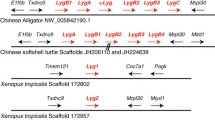Abstract
We have found that mammalian genomes contain two lysozyme g genes. To better understand the function of the lysozyme g genes we have examined the evolution of this small gene family. The lysozyme g gene structure has been largely conserved during vertebrate evolution, except at the 5′ end of the gene, which varies in number of exons. The expression pattern of the lysozyme g gene varies between species. The fish lysozyme g sequences, unlike bird and mammalian lysozyme g sequences, do not predict a signal peptide, suggesting that the encoded proteins are not secreted. The fish sequences also do not conserve cysteine residues that generate disulfide bridges in the secreted bird enzymes, supporting the hypothesis that the fish enzymes have an intracellular function. The signal peptide found in bird and mammalian lysozyme g genes may have been acquired as an exon in the ancestor of birds and mammals, or, alternatively, an exon encoding the signal peptide has been lost in fish. Both explanations account for the change in gene structure between fish and tetrapods. The mammalian lysozyme g sequences were found to have evolved at an accelerated rate, and to have not perfectly conserved the known active site catalytic triad of the bird enzymes. This observation suggests that the mammalian enzymes may have altered their biological function, as well.
Similar content being viewed by others
Author information
Authors and Affiliations
Rights and permissions
About this article
Cite this article
Irwin, D., Gong, Z. Molecular Evolution of Vertebrate Goose-Type Lysozyme Genes . J Mol Evol 56, 234–242 (2003). https://doi.org/10.1007/s00239-002-2396-z
Received:
Accepted:
Issue Date:
DOI: https://doi.org/10.1007/s00239-002-2396-z




